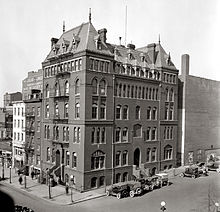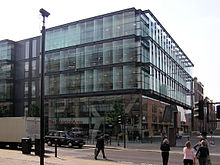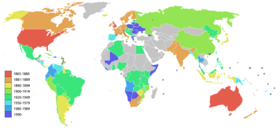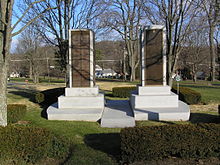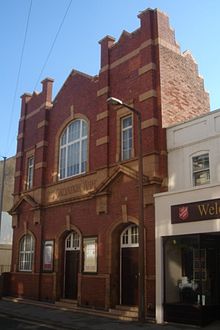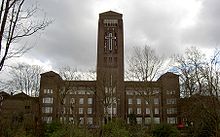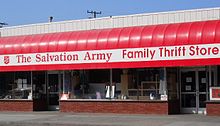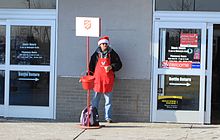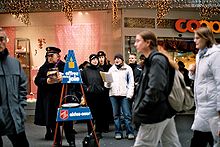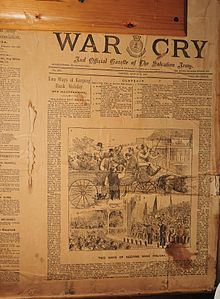
The Salvation Army
About this schools Wikipedia selection
This Wikipedia selection is available offline from SOS Children for distribution in the developing world. Before you decide about sponsoring a child, why not learn about different sponsorship charities first?
| The Salvation Army | |
 |
|
| Classification | Reformed |
|---|---|
| Orientation | Holiness |
| Organizational structure | Hierarchical quasi-military structure |
| Leader | General Linda Bond |
| Geographical areas | Worldwide |
| Headquarters | City of London, United Kingdom |
| Founder | General William Booth |
| Origin | 1865 London, United Kingdom |
| Separated from | Methodism |
| Congregations | 15,175 |
| Members | 1,442,388 |
| Ministers | 25,974 |
| Official website | www.salvationarmy.org |
The Salvation Army is a Christian denomination and international charitable organisation organised in a quasi- military structure. The organisation reports worldwide membership of over 1.5 million, consisting of soldiers, officers and adherents known as Salvationists. Its founders William and Catherine Booth sought to bring salvation to the poor, destitute and hungry by meeting both their "physical and spiritual needs". It has a presence in 126 countries, running charity shops, operating shelters for the homeless, and providing disaster relief and humanitarian aid to developing countries.
The theology of the Salvation Army is mainstream Methodist although it is distinctive in government and practice. The Army's doctrine follow mainstream Christian beliefs, and its articles of faith emphasise God's "saving purposes". Its objects are "the advancement of the Christian religion… of education, the relief of poverty, and other charitable objects beneficial to society or the community of mankind as a whole."
The Army was founded in 1865 in London by one-time Methodist minister William Booth. Originally known as the North London Christian Mission, in 1878 Booth reorganized the mission, becoming its first General and introducing the military structure which has been retained to the present day. The current General of the Army is Linda Bond.
History
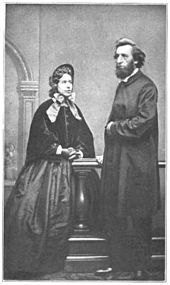
The Salvation Army was founded in London's East End in 1865 by one-time Methodist Reform Church minister William Booth and his wife Catherine. Originally, Booth named the organisation the East London Christian Mission. The name The Salvation Army developed from an incident on 19–20 May. William Booth was dictating a letter to his secretary George Scott Railton and said, "We are a volunteer army." Bramwell Booth heard his father and said, "Volunteer! I'm no volunteer, I'm a regular!" Railton was instructed to cross out the word "volunteer" and substitute the word "salvation". The Salvation Army was modeled after the military, with its own flag (or colours) and its own hymns, often with words set to popular and folkloric tunes sung in the pubs. Booth and the other soldiers in "God's Army" would wear the Army's own uniform, for meetings and ministry work. He became the " General" and his other ministers were given appropriate ranks as " officers". Other members became " soldiers".
When William Booth became known as the General, Catherine was known as the "Mother of The Salvation Army". William preached to the poor, and Catherine spoke to the wealthy, gaining financial support for their work. She also acted as a religious minister, which was unusual at the time; the Foundation Deed of the Christian Mission states that women had the same rights to preach as men. William Booth described the organisation's approach: "The three ‘S's’ best expressed the way in which the Army administered to the 'down and outs': first, soup; second, soap; and finally, salvation."
In 1880, the Salvation Army started its work in three other countries: Australia, Ireland, and the United States. It was not always an official Officer of the Salvation Army who started the Salvation Army in a new country; sometimes Salvationists emigrated to countries and started operating as "the Salvation Army" on their own authority. When the first official officers arrived in Australia and the United States, they found groups of Salvationists already waiting for them.
The Salvation Army's main converts were at first alcoholics, morphine addicts, prostitutes and other "undesirables" unwelcome in polite Christian society, which helped prompt the Booths to start their own church. The Booths did not include the use of sacraments (mainly baptism and Holy Communion) in the Army's form of worship, believing that many Christians had come to rely on the outward signs of spiritual grace rather than on grace itself. Other beliefs are that its members should completely refrain from drinking alcohol (Holy Communion is not practiced), smoking, taking illegal drugs and gambling. Its soldiers wear a uniform tailored to the country in which they work; the uniform can be white, grey, navy, fawn and are even styled like a sari in some areas. Any member of the public is welcome to attend their meetings.
As the Salvation Army grew rapidly in the late 19th century, it generated opposition in England. Opponents, grouped under the name of the Skeleton Army, disrupted Salvation Army meetings and gatherings, with tactics such as throwing rocks, bones, rats, and tar as well as physical assaults on members of The Salvation Army. Much of this was led by pub owners who were losing business because of the Army's opposition to alcohol and targeting of the frequenters of saloons and public houses.
The Salvation Army's reputation in the United States improved as a result of its disaster relief efforts following the Galveston Hurricane of 1900 and the 1906 San Francisco earthquake. The establishment of Victorian bell-ringers raising charity today "helps complete the American portrait of Christmas", with over 25,000 volunteers taking up kettles over the holiday period in the U.S. alone. The church remains a highly visible and sometimes controversial presence in many parts of the world.
In 1994, the Chronicle of Philanthropy, an industry publication, released the results of the largest study of charitable and non-profit organisation popularity and credibility. The study showed that The Salvation Army was ranked as the 4th "most popular charity/non-profit in America" of over 100 charities researched with 47% of Americans over the age of 12 choosing Love and Like A Lot for The Salvation Army.
Charity Watch rates the Salvation Army an "A-" to an "A".
Structure, organisation and expenditures
As of 31 November 2012 the Salvation Army operates in 126 countries and provides services in 175 different languages. For administrative purposes, the Salvation Army divides itself geographically into territories, which are then sub-divided into divisions. In larger areas, regional and area commands are also introduced as sub-divisions of divisions. Each territory has an administrative hub known as territorial headquarters (THQ). Likewise, each division has a divisional headquarters (DHQ). Each of these territories is led by a territorial commander who receives orders from the Salvation Army's International Headquarters in London. A territory is normally led by an officer holding the rank of colonel (for small territories) or commissioner for larger territories. In some countries, the work of The Salvation Army may be called a command, led by a command commander. A larger command is typically led by an officer holding the rank of colonel.
Its stated membership (as quoted from 2010 Year Book) includes 16,938 active and 9,190 retired officers, 1,122,326 soldiers, 189,176 Adherents, 39,071 Corps Cadets, 378,009 Junior Soldiers, around 104,977 other employees and more than 4.5 million volunteers. Members of The Salvation Army also include "adherents", these are people who do not make the commitment to be a soldier but who formally recognize The Salvation Army as their church. (According to the 2006 Salvation Army Year Book, in the United States there are 85,148 Senior Soldiers and 28,377 Junior Soldiers, 17,396 Adherents and around 60,000 employees.)
The Army's leader, General Linda Bond, was elected to this position on 31 January 2011, by The High Council of The Salvation Army. She assumed the rank of General and the mantle of International Leadership at 00:01hrs on 2 April 2011.
The Salvation Army is one of the world's largest providers of social aid, with expenditures including operating costs of $2.6 billion in 2004, helping more than 32 million people in the U.S. alone. In addition to community centers and disaster relief, the organization does work in refugee camps, especially among displaced people in Africa. The Salvation Army has received an A- rating from the American Institute of Philanthropy. In the United Kingdom, The Salvation Army is no longer the largest non-governmental provider of social services; however provides a significant service to people in need. The Salvation Army is the second largest charity in the United States, with private donations of almost $2 billion for the fiscal year ending September 30, 2007.
In 2004, the Army in the United States received a $1.6 billion donation in the will of Joan B. Kroc, third wife of former McDonald's CEO Ray Kroc. This donation was among the largest individual philanthropic gifts ever given to a single organization. The donation came with certain restrictions that caused some controversy.
The International Congress of The Salvation Army is normally held every 10 years as a conference for all Salvationists from around the world to meet. The first such conference took place in London, UK, from 28 May to 4 June 1886, and subsequent Congressional meetings were held sporadically until 1904 and then 1990. The seventh International Congress in Atlanta, GA, USA, from 28 Jun to 2 Jul 2000, was the first held outside of the UK. The next International Congress has been scheduled for July 2015, in commemoration of the 150th Anniversary of The Salvation Army's founding.
Officers are given 'Marching Orders' to change ministries within The Salvation Army. Usually, officers are given new Marching Orders every two to five years and reassigned to different posts, sometimes moving great distances.
A Moscow court ruled that the Salvation Army was a paramilitary organization subject to expulsion. In October 2006, the European Court of Human Rights ruled the original decision illegal.
Beliefs
The beliefs of the Salvation Army rest upon these eleven doctrines:
- We believe that the Scriptures of the Old and New Testaments were given by inspiration of God, and that only they constitute the Divine rule of Christian faith and practice.
- We believe that there is only one God, who is infinitely perfect, the Creator, Preserver, and Governor of all things, and who is the only proper object of religious worship.
- We believe that there are three persons in the Godhead – the Father, the Son and the Holy Spirit, undivided in essence and co-equal in power and glory.
- We believe that in the person of Jesus Christ the divine and human natures are united, so that he is truly and properly God and truly and properly man.
- We believe that our first parents were created in a state of innocence, but by their disobedience they lost their purity and happiness, and that in consequence of their fall all men have become sinners, totally depraved and as such are justly exposed to the wrath of God.
- We believe that the Lord Jesus Christ has by his suffering and death made an atonement for the whole world so that whosoever will may be saved.
- We believe that repentance towards God, faith in our Lord Jesus Christ, and regeneration by the Holy Spirit, are necessary to salvation.
- We believe that we are justified by grace through faith in our Lord Jesus Christ and that he that believeth hath the witness in himself.
- We believe that continuance in a state of salvation depends upon continued obedient faith in Christ.
- We believe that it is the privilege of all believers to be wholly sanctified, and that their whole spirit and soul and body may be preserved blameless unto the coming of our Lord Jesus Christ.
- We believe in the immortality of the soul; in the resurrection of the body; in the general judgment at the end of the world; in the eternal happiness of the righteous; and in the endless punishment of the wicked.
The denomination does not celebrate the Christian sacraments of Baptism and Holy Communion; although its officers conduct marriages, it holds a traditional Protestant belief that marriage was not instituted by Christ and therefore is not a sacrament.
The Salvation Army opposes euthanasia and assisted suicide, and accepts abortion only in extreme cases such as to save the life of the mother. Their official statement says: "The Salvation Army believes in the sanctity of all human life and considers each person to be of infinite value and each life a gift from God to be cherished, nurtured and redeemed. Human life is sacred because it is made in the image of God and has an eternal destiny. (Genesis 1:27) Sacredness is not conferred, nor can it be taken away by human agreement." It is also against the death penalty: "The Salvation Army recognises that the opinions of Salvationists are divided on the moral acceptability of capital punishment and its effectiveness as a deterrent. However, to advocate in any way the continuance or restoration of capital punishment in any part of the world would be inconsistent with the Army’s purposes and contrary to the Army’s belief that all human life is sacred and that each human being, however wretched, can become a new person in Christ."
In 2012, the Salvation Army placed its Positional Statement on Homosexuality "Under review" after receiving adverse publicity about the statement. Prior to 2012, its position was as below.
Practising homosexuals are "ineligible for full membership" in The Salvation Army. The organization will not appoint 'practising' homosexuals to posts as ministers, preferring heterosexuals "whose values are consistent with the church's philosophy."
The ordination of women is permitted in the Salvation Army. Salvation Army officers were previously allowed to marry only other officers (this rule varies in different countries); but this rule has been relaxed in recent years. Husbands and wives usually share the same rank and have the same or similar assignments—the major exception to this is the General's spouse, who is given the rank of Commissioner.
Symbols
Flag
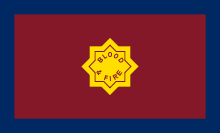
The Salvation Army flag is a symbol of the Army's war against sin and social evils. The red on the flag symbolizes the blood shed by Jesus Christ, the yellow for the fire of the Holy Spirit and the blue for the purity of God the Father.
The star contains the Salvation Army's war cry, 'Blood and Fire'. This describes the blood of Jesus shed on the cross to save all people and the fire of the Holy Spirit which purifies believers.
The flag precedes outdoor activities such as a march of witness. It is used in ceremonies such as the dedication of children and the swearing-in of soldiers. It is sometimes placed on the coffin at the funeral of a Salvationist. Salvationists who have died are said to be "promoted to glory."said by God
Crest
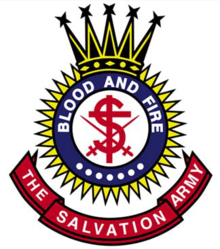
The oldest official emblem of The Salvation Army is the crest.
In 1878 Captain W.H. Ebdon suggested a crest, and in 1879 it was to be found on the letterhead of the Salvation Army Headquarters. The captain's suggested design was changed only slightly and a crown was added.
The meaning of the crest:
The cross: The cross of the Lord Jesus Christ
The "S": Salvation from sin through Jesus
The ray on the outside of the circle: The Fire of the Holy Spirit
The dots: The Truth of the Gospel
The swords: Spiritual Warfare
"Blood and Fire": The Blood which was shed by Jesus for our sins and the Fire of the Holy Spirit
Red Shield
The Red Shield has its origins in Salvation Army work during wartimes. At the end of the 19th century, Staff-Captain Mary Murray was sent by William Booth to support British troops serving in the Boer War in South Africa. Then, in 1901, this same officer was given the task of establishing the Naval and Military League, the forerunner of the Red Shield Services.
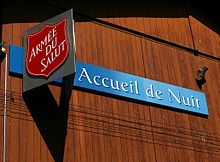
Salvation Army officers serving in the Red Shield Services in wartime performed many functions. The Doughnut Girls of World War I are an early example, serving refreshments to troops in the trenches. They also provided first aid stations, ambulances, chaplaincy, social clubs, Christian worship and other frontline services.
This symbol is still used in Blue Shield Services that serve the British Armed Forces but it is widely used as a simple, more readily identifiable symbol in many Salvation Army settings. It is common to see the Red Shield used on casual Salvation Army uniform.
In Australia, the Red Shield has become one of the country's most identified and trusted brands, leading the Australian Salvation Army to prefer to use this symbol over the crest on its uniform, corps buildings and advertising materials. In the 5th Volume of Australian Superbrands it was recorded that "Research reveals that the popular Salvation Army slogan ‘Thank God for the Salvos’ has almost total recognition amongst the Australian public, achieving 93 per cent aided awareness".
The Salvation Army consistently comes out in research as the charity to which people would most like to donate (named spontaneously).
Similarly the Red Shield logo is highly desired by companies wishing to link their brand with a solid emblem of care and compassion.
The uniform also gives the Salvos a very visible presence, often creating a sense that they are ‘everywhere’, although uniformed Salvationists are actually a very small percentage of the Australian population.
Uniform
Salvation Army officers and soldiers often wear uniforms. The idea that they should do so originated with Elijah Cadman who, at The Salvation Army's 'War Congress' in August 1878 said "I would like to wear a suit of clothes that would let everyone know I meant war to the teeth and salvation for the world". The uniform identifies the wearer as a Salvationist and a Christian. It also symbolises availability to those in need. The uniform takes many forms internationally but is characterized by the 'S' insignia for 'Salvation' and carries the meaning 'Saved to Serve', or 'Serve to Save'. Other letters are substituted to conform with local language.
Tartan
Since 1983 there has been an official Salvation Army tartan. It was designed by Captain Harry Cooper, for the Perth Citadel Corps Centenary commemoration. It is based upon the colours of the Salvation Army Flag, with which it shares the same symbolism. However, it is rarely seen outside Scotland.
Salute
The Salvation Army has a unique form of salute which involves raising the right hand above shoulder-height with the index finger pointing upwards. It signifies recognition of a fellow citizen of heaven, and a pledge to do everything possible to get others to heaven also. In the case of saluting in response to applause, in circumstances such as a musical festival or being applauded for a speech, it also signifies that the Salvationist wishes to give Glory to God and not themselves.
In some instances, the salute is accompanied with a shout of 'hallelujah!'
Services
Music playing
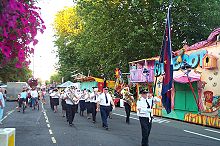
As the popularity of the organization grew and Salvationists worked their way through the streets of London attempting to convert individuals, they were sometimes confronted with unruly crowds. A family of musicians (the Frys, from Alderbury, Wiltshire) began working with the Army as their "bodyguards" and played music to distract the crowds.
The tradition of having musicians available continued and eventually grew into standard brass bands. These are still seen in public at Army campaigns, as well as at other festivals, parades and at Christmas. Across the world the brass band has been an integral part of the Army’s ministry and an immediately recognizable symbol to Salvationists and non-Salvationists alike. The Salvation Army also has choirs; these are known as Songster Brigades, normally comprising the traditional soprano, alto, tenor and bass singers. The premier Songster Brigade in the Salvation Army is the International Staff Songsters (ISS).
The standard of playing is high and the Army operates bands at the international level, such as the International Staff Band (a brass band) which is the equal of professional ensembles although it does not participate in the brass band contest scene, and territorial levels such as the New York Staff Band. Some professional brass players and contesting brass band personnel have Salvation Army backgrounds. Many Salvation Army corps have brass bands that play at Salvation Army meetings, although not all.
The Army tradition in music is to use the popular idiom of the day to reach people for Jesus. The Army's Joy Strings were a hit pop group in the 1960s and early 1970s in the UK and beyond, reaching the charts and being featured on national television. Another popular band is The Insyderz, an American ska-core group popular in the 1990s and early 2000s. Hundreds of current bands carry on this Salvation Army tradition, such as New Zealand's Moped, Chamberlain, Vatic, Agent C, and The Lads; England's Electralyte; Australia's Soteria Music Ministries and Escape; and America's transMission, The Singing Company, HAB, BurN, and CJD – Cookies, Juice, & Donuts. Saytunes is a website designed to encourage and promote these contemporary Salvation Army bands and artists.
Another significant musical feature of the Salvation Army is its use of tambourines. With coloured ribbons representing the colours of the Salvation Army flag, timbrels play an integral facet of music in the Salvation army. They are mainly played by women.
Local corps usually sing contemporary worship music songs in Sunday worship services, as well as traditional hymns and music accompanied by the brass band.
Ensembles
Today it is becoming common in Salvation Army corps not to have a full brass band. This is reflective for many social and cultural reasons. Some Salvation Army corps make use of smaller ensembles of musicians. Often this ensemble consists simply of a guitar, piano or a keyboard, drums and sometimes a bass guitar and other instruments, especially during "Youth Fellowships".
The music played does tend to also take on a more contemporary style as is reflected in modern music today. The early Salvation Army bands were known for their excitement and public appeal, and the modern ensemble keeps to this ideology. Traditional hymns are still used in worship services and these are blended with other musical pieces from Christian Music Publishers such as Vineyard Music, Hillsong, and Planet Shakers to name but a few.
Disaster relief
In the USA The Salvation Army's first major forays into disaster relief resulted from the tragedies of the Galveston Hurricane of 1900 and the 1906 San Francisco earthquake. The Salvationists' nationwide appeals for financial and material donations yielded tremendous support, enabling the Army to provide assistance to thousands. General Evangeline Booth, when she offered the services of Salvationists to President Woodrow Wilson during the First World War, thrust Salvation Army social and relief work to newer heights. Today the Salvation Army is best known for its charitable efforts.
The Salvation Army is a non-governmental relief agency and is usually among the first to arrive with help after natural or man-made disasters. They have worked to alleviate suffering and help people rebuild their lives. After the Indian Ocean tsunami in 2004, they arrived immediately at some of the worst disaster sites to help retrieve and bury the dead. Since then they have helped rebuild homes and construct new boats for people to recover their livelihood. Members were prominent among relief organizations after Hurricane Hugo and Hurricane Andrew and other such natural disasters in the United States. In August 2005, they supplied drinking water to poor people affected by the heat wave in the United States. Later in 2005 they responded to hurricanes Katrina and Rita. They have helped the victims of an earthquake in Indonesia in May 2006.
Since Hurricane Katrina struck the Gulf Coast, The Salvation Army has allocated donations of more than $365 million to serve more than 1.7 million people in nearly every state. The Army’s immediate response to Hurricane Katrina included the mobilization of more than 178 canteen feeding units and 11 field kitchens which together have served more than 5.7 million hot meals, 8.3 million sandwiches, snacks and drinks. Its SATERN ( Salvation Army Team Emergency Radio Network) network of amateur ham-radio operators picked up where modern communications left off to help locate more than 25,000 survivors. And, Salvation Army pastoral care counselors were on hand to comfort the emotional and spiritual needs of 277,000 individuals. As part of the overall effort, Salvation Army officers, employees and volunteers have contributed more than 900,000 hours of service.
The Salvation Army was one of the first relief agencies on the scene of the September 11 attacks in New York. They also provided prayer support for families of missing people.
The Salvation Army, along with the American National Red Cross, Southern Baptist Convention, and other disaster relief organizations, are national members of the National Voluntary Organizations Active in Disaster (NVOAD).
Also among the disaster relief capabilities is the Red Shield Defence Services, often called the SallyMan for short. The effort that they put in is similar to that of a chaplain, and reaches many more, offering cold drinks, hot drinks, and some biscuits for the soldiers of the military to have, though, if a SallyMan is on deployment, the locals are offered a share in the produce.
In Australia the Salvation Army have Emergency Services Support Units throughout the country, providing food and other welfare to members of the Emergency Services such as bushfires, floods, land search, and other both large and small scale emergency operations undertaken by Police, Fire, Ambulance and State Emergency Service members, and the general public affected by these events.
Thrift Stores and charity
The Salvation Army is well known for its network of thrift stores or Charity Shops, colloquially referred to as "the Sally Ann" in Canada, "Sally's" or "Salvo" in the US and "op shops" in Australia, which raise money for its charitable and religious activities by selling donated used items such as clothing, housewares and toys. The Salvation Army has a history of free rehabilitation from alcohol and drug abuse. Thrift stores provide the revenue to run the Adult Rehabilitation Centres known as ARCs. The ARCs, found in many global locations, are work and Bible-based and are usually long-term residential facilities. Clothing collected by Salvation Army stores that are not sold on location are often sold wholesale on the global second hand clothing market.
The Salvation Army operates a fleet of trucks that picks up donations from people's homes to benefit the Thrift Stores. Donations of clothing, furniture and other household items can be scheduled online at SATruck.org. Large scale charity events fuel the network of "Sally's" and are common throughout the year but are most prevalent during the Christmas season.
Red Kettles
In many countries, The Salvation Army is most recognized during the Christmas season with its volunteers and employees who stand outside of businesses and play/sing Christmas carols, or ring bells to inspire passersby to place donations of cash and cheques inside red kettles. A tradition has developed in the United States in which, in some places, gold coins or rings are anonymously inserted into the kettles. This was first recorded in 1982, in Crystal Lake, Illinois, a suburb of Chicago.
Red Shield Appeal
The Red Shield Appeal is an annual fundraising campaign in some territories, such as the UK and Australia. Each year, officers, soldiers, employees and volunteers take to the streets worldwide to participate in door to door or street collections. The money raised is specifically channelled towards The Salvation Army's social work in each respective territory. Within the Territory defined by the United Kingdom and Ireland (UKIT) this collection is known as the Annual Appeal, and it often carries another name that the generally public would more readily know - in 2012 becoming The Big Collection.
Family Tracing Service
The Family Tracing Service (sometimes known as the Missing Persons Service) was established in 1885, and the service is now available in most of the countries where The Salvation Army operates. The Tracing Service's objective is to restore (or to sustain) family relationships where contact has been lost, whether recently or in the distant past. Thousands of people are traced every year on behalf of their relatives.
Youth groups
The Salvation Army includes multiple youth groups, which primarily consist of its Sunday schools and the Scout and Guide packs that are sometimes set up. The Scout and Guide packs are not Salvation Army but are sometimes set up by members of the Salvation Army and are open to anyone. Also some schools volunteer to get a group of kids to help. Some territories have Salvation Army Guards and Legions Association (SAGALA). In the United States these internal youth groups that are specifically for females are known as Girl Guards (older females) and Sunbeams (younger females). Adventure Corps serves boys who are enrolled in school for first through eighth grade.
Alove UK
In the new millennium, The Salvation Army in the United Kingdom created a sub-brand of itself for the youth, called Alove, the Salvation Army for a new generation. Its purpose is to free the youth of the church and their communities to express themselves and their faith in their own ways. Its mission statement is "Calling a generation to dynamic faith, radical lifestyle, adventurous mission and a fight for justice.", and it emphasizes worship, discipleship, missions, and social action. Alove is a member of The National Council for Voluntary Youth Services (NCVYS).
Publications
- The War Cry newspaper, first published in 1879 in the United Kingdom.
- Faith and Friends magazine
- Salvationist magazine

